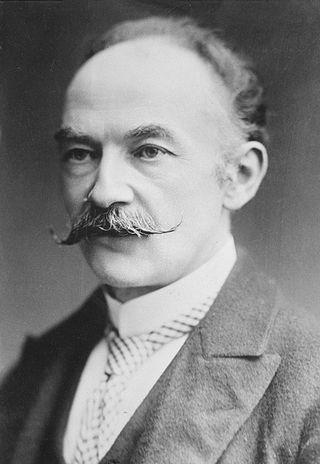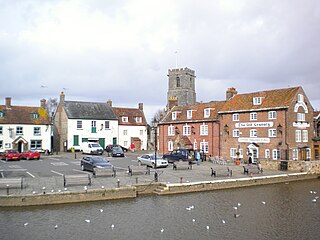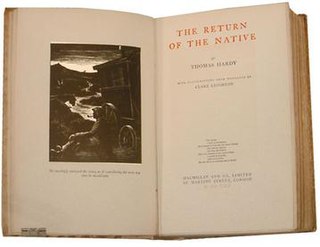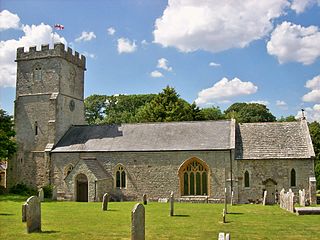
Thomas Hardy was an English novelist and poet. A Victorian realist in the tradition of George Eliot, he was influenced both in his novels and in his poetry by Romanticism, including the poetry of William Wordsworth. He was highly critical of much in Victorian society, especially on the declining status of rural people in Britain, such as those from his native South West England.

Studland is a village and civil parish on the Isle of Purbeck in Dorset, England. The village is located about 2 miles (3.2 km) north of the town of Swanage, over a steep chalk ridge, and 3 miles (4.8 km) south of the South East Dorset conurbation at Sandbanks, from which it is separated by Poole Harbour. The parish includes Brownsea Island within the harbour. In the 2011 census the parish had 182 households and a population of 425, though many of the houses in the village are holiday homes, second homes, or guest houses, and the village's population varies depending upon the season.

The Isle of Purbeck is a peninsula in Dorset, England. It is bordered by water on three sides: the English Channel to the south and east, where steep cliffs fall to the sea; and by the marshy lands of the River Frome and Poole Harbour to the north. Its western boundary is less well defined, with some medieval sources placing it at Flower's Barrow above Worbarrow Bay. John Hutchins, author of The History and Antiquities of the County of Dorset, defined Purbeck's western boundary as the Luckford Lake steam, which runs south from the Frome. According to writer and broadcaster Ralph Wightman, Purbeck "is only an island if you accept the barren heaths between Arish Mell and Wareham as cutting off this corner of Dorset as effectively as the sea." The most southerly point is St Alban's Head.

Wareham is a historic market town and, under the name Wareham Town, a civil parish, in the English county of Dorset. The town is situated on the River Frome eight miles (13 km) southwest of Poole.

The Mayor of Casterbridge: The Life and Death of a Man of Character is an 1886 novel by the English author Thomas Hardy. One of Hardy's Wessex novels, it is set in a fictional rural England with Casterbridge standing in for Dorchester in Dorset where the author spent his youth. It was first published as a weekly serialisation from January 1886.

Flagstones is a late Neolithic interrupted ditch enclosure on the outskirts of Dorchester, Dorset, England. It derives its name from having been discovered beneath the site of the demolished Flagstones House. Half of it was excavated in the 1980s when the Dorchester by-pass was built; the rest of it still exists under the grounds of Max Gate, Thomas Hardy's house.

The Return of the Native is Thomas Hardy's sixth published novel. It first appeared in the magazine Belgravia, a publication known for its sensationalism, and was presented in twelve monthly installments from January to December 1878. Because of the novel's controversial themes, Hardy had some difficulty finding a publisher; reviews, however, though somewhat mixed, were generally positive. In the twentieth century, The Return of the Native became one of Hardy's most popular and highly regarded novels.

Owermoigne is a village and civil parish in the county of Dorset in southern England, situated 6 miles (9.7 km) south-east of Dorchester. In the 2011 census the parish had a population of 467. The parish is within an electoral ward with the same name, which stretches from the east side of the small coastal village of Ringstead north towards Owermoigne and then up to, but not including, Crossways. To the east it covers White Nothe, Holworth and Galton. The population of this ward at the 2011 census was 3,804.

Winfrith Newburgh, commonly called just Winfrith, is a village and civil parish in Dorset, England. It is about 8 miles (13 km) west of Wareham and 10 miles (16 km) east of the county town Dorchester. It was historically part of the Winfrith hundred. In the 2011 Census the civil parish – which includes the hamlet of East Knighton to the northeast – had 300 households and a population of 669. An electoral ward simply named "Winfrith" exists but extends northwards to Briantspuddle. The total population of this ward was 1,618.
KDF9 was an early British 48-bit computer designed and built by English Electric. The first machine came into service in 1964 and the last of 29 machines was decommissioned in 1980 at the National Physical Laboratory. The KDF9 was designed for, and used almost entirely in, the mathematical and scientific processing fields – in 1967, nine were in use in UK universities and technical colleges. The KDF8, developed in parallel, was aimed at commercial processing workloads.

Dorset is a rural county in south west England. Its archaeology documents much of the history of southern England.

South Dorset is a constituency represented in the House of Commons of the UK Parliament since 2010 by Richard Drax, a Conservative. The constituency was created as a consequence of the Redistribution of Seats Act 1885, although the area covered has changed since then.

Thomas Hardy's Wessex is the fictional literary landscape created by the English author Thomas Hardy as the setting for his major novels, located in the south and southwest of England. Hardy named the area "Wessex" after the medieval Anglo-Saxon kingdom that existed in this part of that country prior to the unification of England by Æthelstan. Although the places that appear in his novels actually exist, in many cases he gave the place a fictional name. For example, Hardy's home town of Dorchester is called Casterbridge in his books, notably in The Mayor of Casterbridge. In an 1895 preface to the 1874 novel Far from the Madding Crowd he described Wessex as "a merely realistic dream country".

Walter Frederick Roope Tyndale (1855–1943) was a British watercolourist of landscapes, architecture and street scenes, book illustrator and travel writer.

In literature regionalism refers to fiction or poetry that focuses on specific features, such as dialect, customs, history, and landscape, of a particular region. The setting is particularly important in regional literature and the "locale is likely to be rural and/or provincial."
Egdon Heath, Op. 47, H. 172, subtitled "A Homage to Thomas Hardy", is a tone poem by Gustav Holst, written in 1927. Holst considered it his most perfectly realised composition.
Gertrude Bugler was a British stage actress of the Edwardian Era best known for acting in plays adapted by Thomas Hardy.

Maiden Castle by John Cowper Powys was first published in 1936 and is the last of Powys so-called Wessex novels, following Wolf Solent (1929), A Glastonbury Romance (1932), Weymouth Sands (1934). Powys was an admirer of Thomas Hardy, and these novels are set in Somerset and Dorset, part of Hardy's mythical Wessex. American scholar Richard Maxwell describes these four novels "as remarkably successful with the reading public of his time". Maiden Castle is set in Dorchester, Dorset Thomas Hardy's Casterbridge, and which Powys intended to be a "rival" to Hardy's Mayor of Casterbridge. Glen Cavaliero describes Dorchester as "vividly present throughout the book as a symbol of the continuity of civilization. The title alludes to the Iron Age, hill fort Maiden Castle that stands near to Dorchester.
The Hardy Players (1908–1928) was an amateur theatrical company, based in Dorchester, Dorset. The novelist Thomas Hardy adapted his novels for live performance in collaboration with the group. In some cases he made major changes to the story, such as changing the ending of The Trumpet Major, truncating Return of the Native and making other changes to the text to better fit dramatisation. Hardy wrote his play The Famous Tragedy of the Queen of Cornwall specifically to be performed by the Hardy Players.














